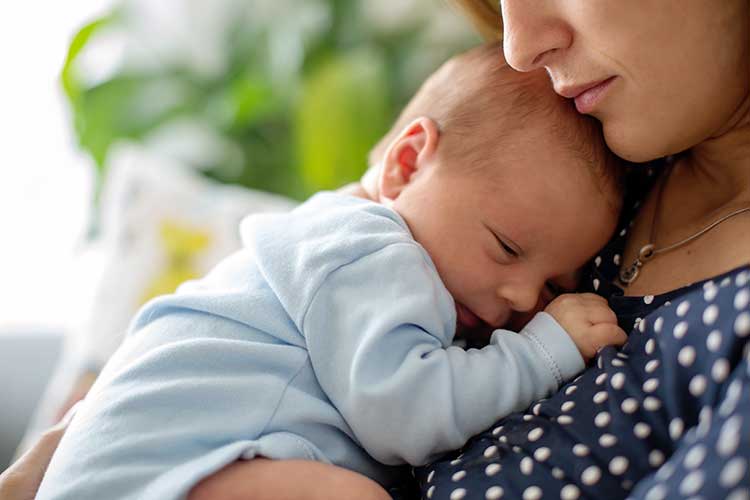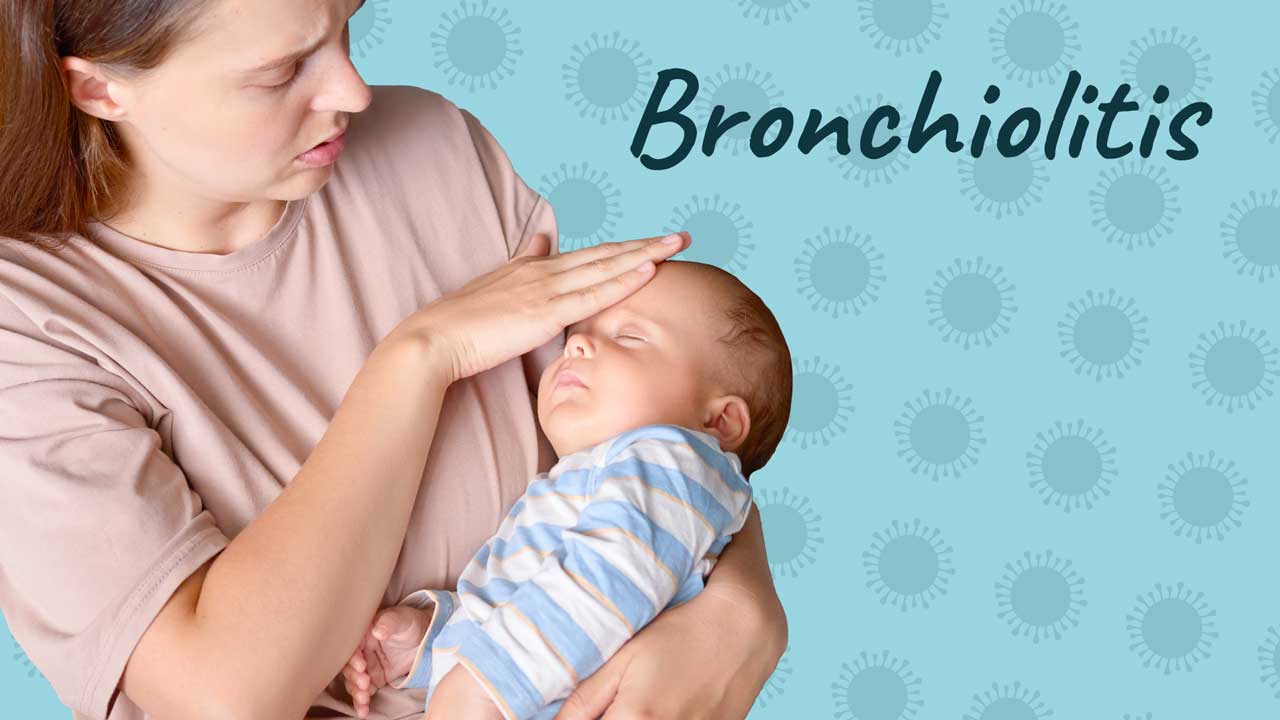Bronchiolitis is one of the most common causes of hospital admission for Australian infants (PREDICT 2025).
What is Bronchiolitis?
Bronchiolitis is a viral lower respiratory infection characterised by inflammation and an accumulation of mucus in the bronchioles. This causes the bronchioles to narrow and consequently results in mild to moderate respiratory distress (Raising Children Network 2023; Justice & Le 2023).
Bronchiolitis is most commonly caused by the respiratory syncytial virus (RSV) (Healthdirect 2024). Almost every child will experience an RSV infection by two years of age (AIH 2025).
Bronchiolitis can also be caused by several other viruses, including parainfluenza viruses, adenoviruses, and even SARS-CoV-2 (the virus that causes COVID-19) (Justice & Le 2023; Schroeder & Nicholson 2024).
Bronchiolitis most commonly affects infants under six months of age, but may also occur in those up to 12 months old (Better Health Channel 2022).
How Does Bronchiolitis Spread?
The viruses causing bronchiolitis are spread by breathing in the respiratory secretions emitted when an infected individual talks, coughs or sneezes. Bronchiolitis can also be transmitted by touching a surface contaminated by a virus and then touching the eyes, nose or mouth (Healthdirect 2024).
Symptoms of Bronchiolitis

Bronchiolitis typically starts as an acute upper respiratory tract infection. The infant may then begin to experience one or more of the following symptoms:
- Coughing
- Fever
- Tachycardia (rapid breathing)
- Noisy breathing
- Apnoeic episodes
- Breathing difficulties - the infant may display tracheal tug (the chest sinking in when they attempt to breathe), nasal flaring or head bobbing
- Feeding difficulties
- Irritability.
(RCHM 2018, 2023)
Due to the thick secretions associated with bronchiolitis, babies may have difficulty feeding. Secretions block the nares, making breast and bottle feeding difficult. Babies may struggle to breathe and feed at the same time and can tire quickly (SCHN 2025).
Symptoms typically last 7 to 10 days, with peak severity at days 2 to 3, but the cough may persist for up to 2 to 4 weeks (SCHN 2025).
Assessing the Severity of Bronchiolitis
The following table can be used to assess the severity of bronchiolitis symptoms:
| Mild | Moderate | Severe | Life-threatening | |
| Behaviour |
|
|
|
|
| Colour | Normal | Pallor | Pallor/cyanosis | Cyanosis |
| Respiratory rate (at rest, not crying) | Normal to mild tachypnoea | Increased respiratory rate | Increased respiratory rate | Markedly increased/bradypnoea/apnoea |
| Increased work of breathing | None or minimal | Moderate | Marked | Severe accessory muscle use or poor respiratory effort |
| Oxygenation | SpO2 < 90% (in room air) | |||
| Heart rate | Normal or slightly increased | Mildly increased | Significantly increased/bradycardia | Arrhythmia/bradycardia |
| Blood pressure | Normal | Increased | Increased | Hypotension |
(Adapted from RCHM 2024)
Risk Factors for Bronchiolitis
The following risk factors increase the risk of severe illness from bronchiolitis:
- Prematurity (born under 37 weeks gestation)
- Being under 10 weeks of age
- Prenatal/postnatal tobacco exposure
- Limited exposure to breastfeeding
- Slow weight gain
- Chronic lung disease
- Congenital heart disease
- Chronic neurological condition
- Aboriginal or Torres Strait Islander ethnicity
- Immunodeficiency
- Trisomy 21 (Down syndrome)
- Economic disadvantage.
(RCHM 2023; PREDICT 2025)
Infants with any of these risk factors may deteriorate rapidly. Therefore, admission to the hospital should be considered even if the infant initially presents with mild symptoms (RCHM 2023).
Diagnosing Bronchiolitis
Bronchiolitis is usually diagnosed clinically, based on signs and symptoms. Most children don't require diagnostic investigations unless their condition is deteriorating or there is diagnostic uncertainty (RCHM 2023).
Investigations such as chest x-rays, blood tests and virological testing are not recommended for routine use (PREDICT 2025).
Treating Bronchiolitis
Infants with mild symptoms can usually be treated at home. Management should include:
- Rest
- Giving shorter, more frequent feeds to prevent dehydration and fatigue
- Administering paracetamol or ibuprofen to manage fever (always ensure you give the correct dose).
(SCHN 2025)

If symptoms are more severe, the infant may need to be admitted to the hospital. Treatment is supportive, with oxygenation and fluids administered as required (RCHM 2023). Minimal handling in a calm, quiet environment has been a long-recommended strategy. The more the child becomes distressed, the more respiratory problems they experience.
Nasal saline drops are not routinely recommended but may be trialled to help loosen secretions to allow feeding. Nasal suctioning may be required in some cases, but it is not routinely recommended. Infants who have severe difficulty feeding may require nasogastric (NG) feeding. Frequent, small feeds are preferred (either oral or NG) (PREDICT 2025; RCHM 2023).
Intravenous hydration should only be used if the NG route is unsuitable (PREDICT 2025; RCHM 2023).
Bronchiolitis is caused by a virus and therefore does not respond to antibiotics. Other medicines are not indicated in treatment either (RCHM 2023).
When to Escalate Care
Care should be escalated if the infant is displaying any of the following symptoms:
- Wheezing or breathing difficulties
- Rapid breathing
- Eating less than half of their normal intake
- Fewer wet nappies than usual
- Sudden worsening of symptoms
- Very tired or irritable, or difficult to wake.
(Healthdirect 2024)
Signs of an emergency requiring immediate medical attention include:
- Severe breathing difficulties or exhaustion from trying to breathe
- Cyanosis
- Apnoeic episodes.
(Healthdirect 2024)
Conclusion
Bronchiolitis is one of the leading causes of infant hospitalisation. Knowing how to recognise the severity of the infection and manage its symptoms will help you provide the best patient care, particularly in the winter months when the illness is most prevalent.
Test Your Knowledge
Question 1 of 3
Typically, when does bronchiolitis reach peak severity?
Topics
Further your knowledge
References
- Australian Immunisation Handbook 2025, Respiratory Syncytial Virus (RSV), Australian Government, viewed 3 July 2025, https://immunisationhandbook.health.gov.au/contents/vaccine-preventable-diseases/respiratory-syncytial-virus-rsv
- Better Health Channel 2022, Bronchiolitis, Victoria State Government, viewed 3 July 2025, https://www.betterhealth.vic.gov.au/health/conditionsandtreatments/bronchiolitis
- Healthdirect 2024, Bronchiolitis, Australian Government, viewed 3 July 2025, https://www.healthdirect.gov.au/bronchiolitis
- Justice, NA & Le, JK 2023, ‘Bronchiolitis’, StatPearls, viewed 3 July 2025, https://www.ncbi.nlm.nih.gov/books/NBK441959/
- Paediatric Research in Emergency Departments International Collaborative 2025, Australasian Bronchiolitis Guideline: 2025 Update, PREDICT, viewed 3 July 2025, https://www.predict.org.au/bronchiolitis-guideline/
- Raising Children Network 2020, Bronchiolitis, Raising Children Network, viewed 2 June 2022, https://raisingchildren.net.au/guides/a-z-health-reference/bronchiolitis
- Royal Children's Hospital Melbourne 2018, Bronchiolitis, RCHM, viewed 3 July 2025, https://www.rch.org.au/kidsinfo/fact_sheets/Bronchiolitis/
- Royal Children's Hospital Melbourne 2023, Clinical Practice Guidelines: Bronchiolitis, RCHM, viewed 3 July 2025, https://www.rch.org.au/clinicalguide/guideline_index/Bronchiolitis/
- Royal Children's Hospital Melbourne 2023, Clinical Practice Guidelines: Assessment of Severity of Respiratory Conditions, RCHM, viewed 3 July 2025, https://www.rch.org.au/clinicalguide/guideline_index/assessment_of_severity_of_respiratory_conditions/
- Schroeder, A & Nicholson, E 2024, Patient Education: Bronchiolitis and RSV in Infants and Children (Beyond the Basics), UpToDate, viewed 3 July 2025, https://www.uptodate.com/contents/bronchiolitis-and-rsv-in-infants-and-children-beyond-the-basics
- Sydney Children’s Hospital Network 2025, Bronchiolitis, New South Wales Government, viewed 3 July 2025, https://www.schn.health.nsw.gov.au/files/factsheets/bronchiolitis-en.pdf
 New
New 

